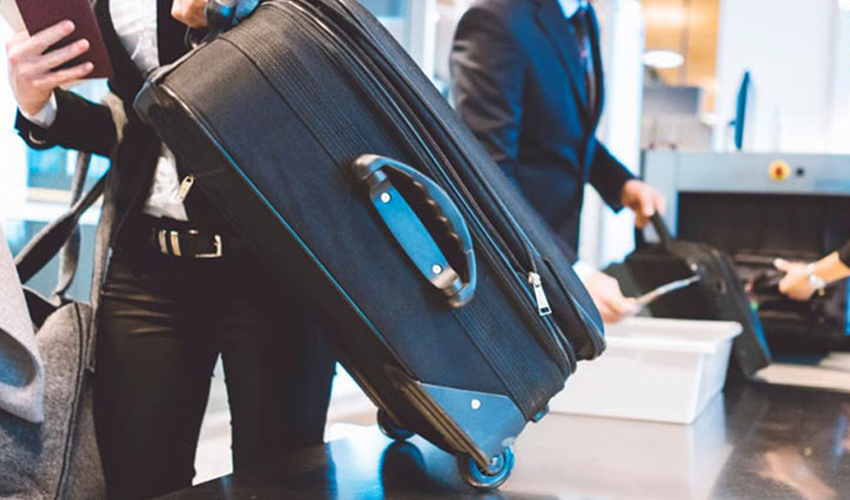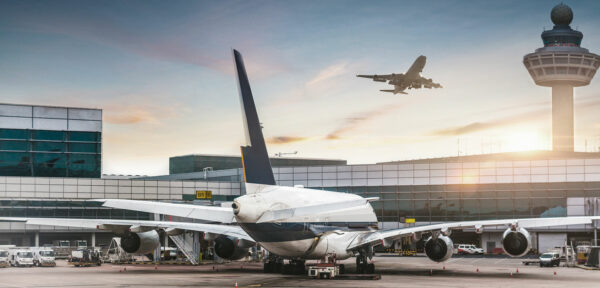Before the Coronavirus outbreak, we used to see airports as crowded and highly transited spaces. The term “physical distancing” was barely known beyond the field of epidemiology. Today, the health crisis has brought a new reality. Scientific findings have determined that the main routes of COVID-19 transmission are via respiratory droplets. Therefore, health organizations have called on the public to avoid close contact with other people. For decision makers, this means that task and resource planning must allow social distancing in airport operations.
Being at least 1.5 meters from one another seems to be the most effective method to limit the virus’ spread. Now that fewer flights are running, we could expect a reduced complexity in airport operations. That could also suggest that social distancing can be easily guaranteed. But is that really the case? Moreover, what will happen when travel demand starts ramping up? Measures like temperature screening could potentially lead to the formation of long queues. Restraints in the utilization of airport infrastructure may cause delays and trigger agglomerations. Both of these situations make the development of strategies to achieve physical distancing goals essential.
Key considerations for implementing social distancing in airport operations
1. Identify critical processes across operational areas
The first step should be to determine hotspots across functional areas where there may be a greater exposure risk. Check-in, security and boarding are among the points where a high density of travelers and agents can be expected. The limitations associated with an airport’s layout also can create challenges to maintaining social distancing. Creating additional space could increase the cost pressures that airports are already experiencing. A COVID-conscious risk assessment becomes indispensable to find the most effective ways to keep social distancing in airport operations.
The identification of potential hazards should be based on passengers´ behavior and specific personnel roles. This means operators need to understand the traveler´s flow and the unique ways each staff team works. As the situation evolves rapidly, risk assessments must remain as flexible and updated as possible. Considering them in the planning process will facilitate more educated decision making. For example, access restrictions can be introduced to certain terminals depending on the risk level of the country from which the flight originates. Passenger crossings can then be prevented even in domestic routes.
2. Evaluate the impact of ensuring social distancing in airport operations
Keeping the established 1.5-meter gap is inevitably transforming the way tasks are performed. Such changes impact ultimately in the overall travel experience. Increasing processing times and expenses, as well as reduced capacity utilization, force managers to review existing workflows and structures:
- Fewer travelers will be allowed to occupy spaces that used to be highly transited. Therefore, planners have to assess capacity on an ongoing basis, especially when traffic volumes start to increase.
- The implementation of physical distancing will create new tasks. This might extend the time travelers have to stay at the airport. A smart allocation of check-in desks, baggage belts and other resources should enable more efficiency.
- Boarding and bussing times are expected to be slower to avoid crowding at gates and buses. This could require counting with larger queue and flow areas.
- Additional methods will be required to convey social distancing to passengers and employees. Posters, floor markings and other types of signage can facilitate this. Resources needed for the installation and maintenance of these visual reminders will have to be planned.
- Operators need flexible solutions to keep passengers well informed, for instance about possible congestions at terminals. Continuous communication with personnel is also essential to optimize the allocation of teams in real-time and prevent crowding.


3. Incorporate the outcomes of your analysis in your planning tool
Decision makers should ensure that the results of the first two steps previously described are accounted for in the planning process. Understanding the risks of contagion and the implications of implementing social distancing in airport operations becomes crucial to achieve more efficiency. A great challenge resulting from the current situation is the optimal allocation of resources. While some airports may be able to extend their capacity, the majority must focus on maximizing the usage of their existing resources.
Companies are already dealing with reduced manpower due to part-time or furlough policies. Keeping the available staff safe is a must. By minimizing contact between team members, mandatory quarantine can be avoided. Otherwise, this measure would further reduce available workforce leading to possible reduced coverage. Once more flights resume, this could generate delays and costly inconveniences. An intelligent planning system can calculate various what-if scenarios overnight for optimal rostering. Thus, decision makers can split staff teams in a way that provides enough geographical and shift time separation.
From a passenger perspective, operators have to comprehend where travelers were, are and will be to avoid overcrowding. Forecasting show-up profiles in the check-in area can help to estimate the number of counters needed. With this information, planners can determine which desks should be open, guaranteeing that there is enough space among travelers. That is especially helpful, to separate visitors coming from risk areas from other flights. Based on flight schedules, passenger numbers and arrival profiles, smart queue planning facilitates physical distancing. Overflows and bottlenecks can be prevented thanks to a proper deployment of staff and resources.
4. Leverage digital technologies and adapt
Digital tools are set to play a crucial role in implementing social distancing in airport operations. Advanced software can facilitate a prompt response to occurrences by optimally dispatching terminal resources. For example, if agglomeration is being generated in security lanes, agents can communicate with frontline managers to report the current situation. Further support can be requested in a matter of seconds. Managers can quickly visualize which resources are available. Flexible solutions enable access to this essential information from mobile devices at any time, increasing situational awareness.
Another interesting tool supporting physical distancing is contact tracing. Performing this task manually is highly time consuming and inefficient. A combination of hardware and software solutions can facilitate collecting and analyzing real-time data on staff contacts. In combination with other technologies like those aimed at monitoring passengers´ flow, operators can better understand the dynamics of areas where people are too close. Based on this input, it can be decided, for instance, whether to widen the stanchions in the queues or if the access to the terminal should be restricted.
Conclusion
Implementing social distancing in airport operations will play a crucial role in the recovery of the aviation industry. Decision makers should consider it in their planning process to comply with regulations and increase resilience to future threats. Incorporating this preventive measure though will be more challenging when traffic numbers increase and airport capacity further contracts. The ability to adapt to the New Normal will depend on whether operators are willing to embrace change and rethink regular processes.
The current situation can be an opportunity for decision makers to address pain points that existed before the Coronavirus outbreak. By adopting advanced technologies and new practices, airports can expedite tasks and achieve greater efficiency, while keeping the public safe. AI-based software can help distribute staff in smaller and more stable teams, dramatically reducing the risk of infection. Likewise, resources can optimally be allocated based on demand forecasting and the analysis of multiple scenarios.
Physical distancing is most likely here to stay, so solutions for a longer term will be needed. In any case, training staff is a factor that should not be omitted. Employees are facing an uncertain environment with new activities that demand specialized knowledge. In these difficult times, more than ever, manpower needs support. Personnel must be aware of social distancing requirements and know how to best incorporate them into their daily routine. Providing daily briefings on this protocol is crucial – not only to keep staff safe, but also to assure passengers.





0 comments on “4 Steps to Effectively Implement Social Distancing in Airport Operations”